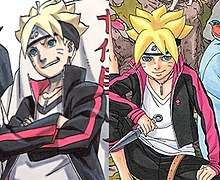Mikio Ikemoto
Mikio Ikemoto (池本 幹雄, Ikemoto Mikio, born January 13, 1977) is a Japanese manga artist. He originally worked as an assistant for Masashi Kishimoto's manga series Naruto from 1999 to 2014. After its ending, Ikemoto has been working since 2016 on the sequel series, Boruto: Naruto Next Generations, alongside writer Ukyo Kodachi.
Biography and works

As a child Ikemoto was a fan of Bikkuriman stickers. However, since he could not afford them, he instead drew his own stickers. Ikemoto's friends enjoyed them so much that they started buying stickers from him. By this point of his life, Ikemoto felt he had the talent for art.[1]
Mikio Ikemoto first wrote a one-shot manga titled Cosmos for the manga magazine Weekly Shōnen Jump, which granted him an award in 1997. By that time, Ikemoto had become interested in Masashi Kishimoto's works as he was also a rookie in manga. When hearing that Ikemoto had been contacted by Shueisha to make a gag series, Kishimoto felt that his art might suit another type of series. Thus, he asked his superior to meet Ikemoto and let him work as one of his assistants. Ikemoto was grateful for this job, since he felt that Naruto's genre was what he had originally wanted. During the making of Naruto, Ikemoto was Kishimoto's youngest assistant, and the latter jokingly said this made him and his other assistants envious.[2] Ikemoto was responsible for drawing crowds and background figures, adding white to speed lines, highlights and characters' eyes, whiting out art that went out of the panels, putting stars in night skies, and adding in half-tones.[2] Ikemoto recalls how often Kishimoto requested his help with adding more details to the manga chapters, leading him to draw more clones created by Naruto Uzumaki as well as an unspecified character who could become giant.[3]
When the manga ended in 2014, Shueisha asked Kishimoto to start a sequel. However, Kishimoto rejected the idea and proposed Ikemoto to draw it based on the experience he had.[4] Kishimoto advised Ikemoto not to imitate his art style and instead make his own. While noting long-time fans might be disappointed with the fact that Kishimoto is not drawing Boruto, Ikemoto stated he would do his best in the making of the manga. Ikemoto mentioned he remained optimistic about his art style. Kishimoto also revises the manga's scenario.[5] Besides illustrating the manga, Ikemoto also provides illustrations for the Boruto light novels.[6] The manga had one million copies in print as of January 2017 while Studio Pierrot also produced an anime series based on it.[7]
Style
Aside from Naruto, Ikemoto said his art was influenced by Kinnikuman and particularly Dragon Ball. He noted that the lack of tone in Akira Toriyama's art makes drawing easier and said he still uses Dragon Ball as a reference for his own action scenes. Ikemoto admitted he is pretty bad at drawing comedy, but also noted that the way the story of Boruto has evolved does not lend itself well to comedy.[8] While feeling honored to create the art for Boruto, Ikemoto stated he feels grateful that the series is released monthly rather than weekly due to the stress the latter could bring since the required amount of pages is nearly 20 per chapter. However, Ikemoto still finds the monthly serialization challenging. Regular chapters of Boruto tend to surpass 40 pages, with one week required to create the thumbnails and 20 days to produce the pages while the rest of the time is used for coloring or giving the chapters other touches.[9] His drawing methods involve criterium (Mechanical Pencil) on IC's paper for the sketches. He uses ink for finished drawings. Despite the differences between their art styles, Ikemoto uses Copic's markers for the colored pages, similarly to how Kishimoto did with Naruto.[5]
The Boruto anime's director Hiroyuki Yamashita said he enjoys Ikemoto's style, praising his oblong landscape layout for frames. He found Ikemoto's style more realistic than Kishimoto's due to the former's attention to the character designs' details. He also pointed out that Ikemoto's way of illustrating Momoshiki Otsutsuki's new appearance after consuming Kinshiki Otsutsuki surprised him due to how different it was compared to the original design from the Boruto movie.[10] Amy McNulty of Anime News Network shared similar comments, particularly regarding the way Ikemoto's art resembles Kishimoto's as well as how well-illustrated his fight scenes are.[11] Manga author Yoshihiro Togashi stated he enjoyed Ikemoto's artwork, praising his style.[1]
References
- Bae, John (September 6, 2016). "Togashi x Kishimoto Discuss Worldbuilding". Jump Giga. Viz Media. Retrieved June 16, 2018.
- Kishimoto, Masashi (2005). Naruto. 6. Viz Media. p. 106. ISBN 978-1-59116-739-6.
- Kishimoto, Masashi; Ikemoto, Mikio; Morimoto, Mari (2017). Boruto: Naruto Next Generations. 1. Viz Media. p. 1. ISBN 978-1-4215-9584-9.
- "Masashi Kishimoto X Ikemoto Full Interview English". Weekly Shonen Jump. Spiralling Sphere. July 31, 2016. Retrieved October 24, 2017.
- "Le manga de la semaine: Mikio Ikemoto commente Boruto, le spin-off de Naruto" (in French). BFMTV. Retrieved January 14, 2018.
- "Boruto - Naruto Next Generations Novel/5" (in Japanese). Shueisha. Retrieved February 21, 2018.
- "Boruto: Naruto Next Generations Anime Features Original Story". Anime News Network. Retrieved June 1, 2017.
- Morrissy, Kim (February 25, 2019). "Interview: Boruto Manga Artist Mikio Ikemoto". Anime News Network. Retrieved February 25, 2019.
- Kishimoto, Masashi; Ikemoto, Mikio; Morimoto, Mari (2017). Boruto: Naruto Next Generations. 2. Viz Media. p. 1. ISBN 978-1-4215-9584-9.
- Kishimoto, Masashi (2017). Naruto TV Anime Premium Book: Naruto The Animation Chronicle Ten. Shueisha. ISBN 9784087925142.
- McNulty, Amy (April 2, 2017). "Review". Anime News Network. Retrieved March 9, 2018.
